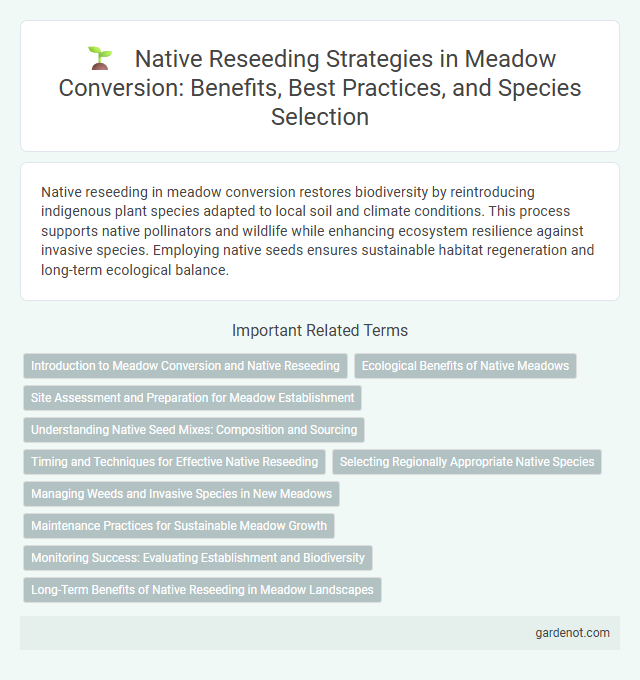Native reseeding in meadow conversion restores biodiversity by reintroducing indigenous plant species adapted to local soil and climate conditions. This process supports native pollinators and wildlife while enhancing ecosystem resilience against invasive species. Employing native seeds ensures sustainable habitat regeneration and long-term ecological balance.
Introduction to Meadow Conversion and Native Reseeding
Meadow conversion involves transforming conventional lawns or non-native plant areas into native meadow ecosystems, promoting biodiversity and ecological balance. Native reseeding utilizes local seed varieties adapted to regional climates and soils, enhancing habitat restoration and supporting pollinators. This approach reduces maintenance needs and fosters sustainable, resilient landscapes that naturally support wildlife and improve soil health.
Ecological Benefits of Native Meadows
Native reseeding in meadow conversion enhances biodiversity by providing essential habitats for pollinators such as bees and butterflies, which support ecosystem health and crop pollination. These native meadows improve soil quality through deep-rooted plants that prevent erosion and promote nutrient cycling. Furthermore, they increase carbon sequestration, helping mitigate climate change by storing more carbon in soils compared to conventional grasslands.
Site Assessment and Preparation for Meadow Establishment
Effective site assessment for native reseeding involves analyzing soil composition, pH levels, and existing vegetation to ensure optimal conditions for meadow establishment. Preparing the site requires removing invasive species and compacted materials, followed by tilling and amending the soil to enhance nutrient retention and water drainage. Selecting native seed mixes suited to local climate and soil characteristics increases the success rate of meadow restoration and promotes biodiversity.
Understanding Native Seed Mixes: Composition and Sourcing
Native seed mixes for meadow conversion are carefully composed of region-specific grasses, wildflowers, and legumes that promote biodiversity and ecosystem resilience. Sourcing these seeds from local or reputable suppliers ensures genetic compatibility and enhances the success of plant establishment and long-term sustainability. Understanding the precise composition allows land managers to tailor mixes to soil conditions, climate, and conservation goals, maximizing ecological benefits and habitat restoration.
Timing and Techniques for Effective Native Reseeding
Optimal timing for native reseeding in meadow conversion occurs during early spring or late summer when soil temperatures range between 50degF and 65degF, promoting seed germination and establishment. Effective techniques include scarifying the soil to enhance seed-to-soil contact, broadcasting native seed mixes that mimic local biodiversity, and lightly raking or rolling the area to ensure proper seed coverage. Consistent post-seeding moisture management and minimizing soil disturbance over the first growing season significantly increase native seedling survival rates.
Selecting Regionally Appropriate Native Species
Selecting regionally appropriate native species for meadow conversion ensures ecological compatibility and promotes biodiversity by supporting local wildlife habitats. Native plants adapted to the specific climate and soil conditions require less maintenance and enhance ecosystem resilience against invasive species. Using regional seed sources improves germination success and fosters a sustainable, balanced meadow ecosystem.
Managing Weeds and Invasive Species in New Meadows
Effective management of weeds and invasive species during native reseeding in meadow conversion ensures the establishment of diverse, resilient plant communities. Targeted removal techniques and selective herbicide application minimize competition, promoting native species growth and ecosystem balance. Monitoring and adaptive management are critical to prevent reinfestation and support long-term meadow health and biodiversity.
Maintenance Practices for Sustainable Meadow Growth
Native reseeding supports sustainable meadow growth by enhancing soil health and promoting biodiversity. Regular maintenance practices include selective mowing, controlled grazing, and targeted weed management to prevent invasive species dominance. Monitoring soil moisture and nutrient levels ensures optimal conditions for native plant establishment and resilience.
Monitoring Success: Evaluating Establishment and Biodiversity
Monitoring success in native reseeding for meadow conversion involves regular assessment of plant establishment rates and species diversity to ensure ecosystem resilience. Quantitative surveys of vegetation cover, species richness, and presence of target native species provide critical data on restoration progress. Biodiversity indices combined with soil health metrics offer insights into long-term ecological stability and guide adaptive management strategies.
Long-Term Benefits of Native Reseeding in Meadow Landscapes
Native reseeding in meadow landscapes enhances biodiversity by reintroducing indigenous plant species that support local wildlife and pollinators. This practice improves soil health through increased organic matter and root diversity, promoting resilience against erosion and climate variability. Over time, native reseeding fosters ecological stability and sustains ecosystem services critical for environmental balance and habitat preservation.
Native reseeding Infographic

 gardenot.com
gardenot.com